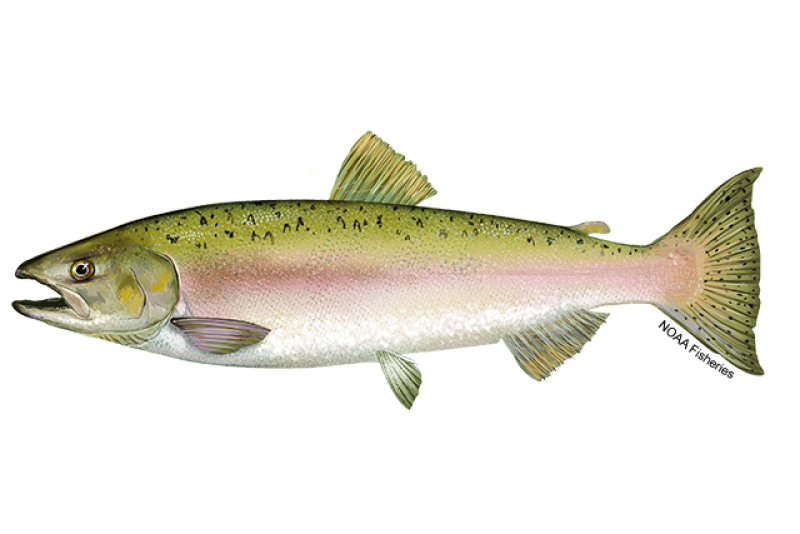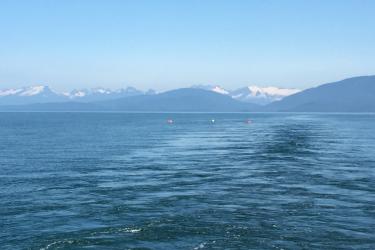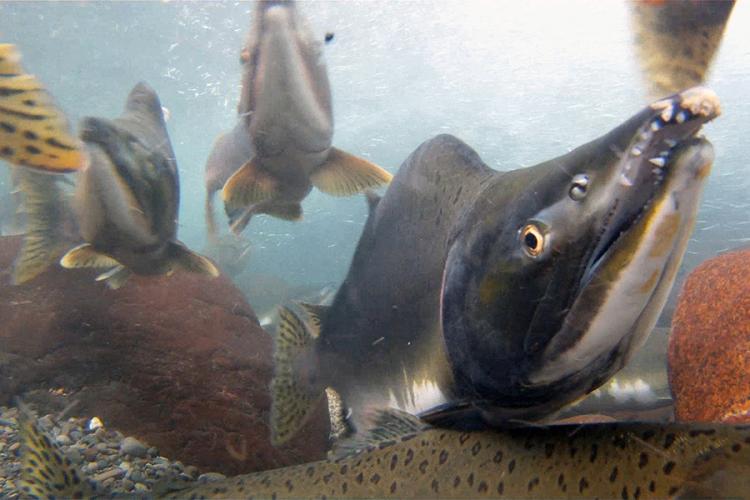 Pink salmon. Credit: NOAA Fisheries
Pink salmon. Credit: NOAA Fisheries
Pink salmon. Credit: NOAA Fisheries
About the Species
 Pink salmon. Credit: NOAA Fisheries
Pink salmon. Credit: NOAA Fisheries
Pink salmon. Credit: NOAA Fisheries
U.S. wild-caught pink salmon is a smart seafood choice because it is sustainably managed and responsibly harvested under U.S. regulations.
NOAA Fisheries works in cooperation with federal, state, tribal, and Canadian officials to manage these commercial, recreational, and tribal harvest of salmon and steelhead in ocean and inland waters of the West Coast and Alaska. To learn more about management of these fisheries, visit our West Coast and Alaska fisheries management pages.
Appearance
- Pink salmon are the smallest of the Pacific salmon found in North America, weighing between 3.5 and 5 pounds, with an average length of 20 to 25 inches.
- Pink salmon can be distinguished from other Pacific salmon by the large dark oval spots on their back and entire tail fin as well as their general coloring and form.
- In the sea, pink salmon are steel blue to blue-green on the back, silver on the sides, and white on the belly.
- Breeding males become dark on the back and red with brownish green blotches on the sides.
- Males also develop a hump on their back, which is why they are often called “humpback” salmon.
- Breeding females are similar but lack a dorsal hump and are less distinctly colored.
Biology
- Pink salmon are anadromous – they hatch in freshwater streams and rivers then migrate out to the saltwater environment of the ocean to feed and grow.
- Unlike coho, Chinook, or sockeye salmon, pink salmon do not reside in fresh water for an extended period.
- Young pink salmon (fry) typically migrate directly to estuarine and marine waters soon after they are born.
- Once they reach the ocean, they feed voraciously and grow rapidly. In fact, they’re among the fastest growing of the Pacific salmon species.
- After about 1½ years of feeding and growing in the ocean, maturing pink salmon return to fresh water to spawn, usually from August to October.
- Females construct nests (redds) in the riverbed by turning on their sides and vigorously flexing their bodies and tails, digging a shallow hole.
- Females deposit between 1,200 and 1,900 eggs in the redds, which the males then fertilize.
- The female stays and defends her redd from other females until she dies, usually within two weeks.
- All pink salmon die after they spawn.
- They typically spawn at the age of 2.
- Because the pink salmon life cycle is so regular, independent populations spawn in even and odd years. For example, in the southern part of their range, they usually spawn in odd years in most river systems. However, pink salmon do spawn in even years in some Puget Sound rivers.
- Throughout most of Alaska, there is no dominant year, except in the northwestern part of Alaska where even-year runs predominate.
- Pink salmon feed on small crustaceans, zooplankton (tiny floating animals), squid, and small fish.
- In fresh water, aquatic invertebrates, other fishes, birds, and small mammals prey on pink salmon eggs, alevins, and fry.
- In the ocean, other fishes (including other Pacific salmon) and coastal seabirds prey on pink salmon fry and juveniles.
- Marine mammals, sharks, other fishes (such as Pacific halibut), and humpback whales feed on adult pink salmon.
- In freshwater spawning habitats, bears are predators of adult pink salmon. Wolves, river otters, and bald eagles will also occasionally eat pre-spawning adult pinks.
- After salmon spawn and die, salmon carcasses are a valuable source of energy and nutrients to the river ecosystem. Carcasses have been shown to improve newly hatched salmon growth and survival by contributing nitrogen and phosphorous compounds to streams.
Where They Live
Range
- Pink salmon are found on both sides of the North Pacific, from Alaska to Puget Sound in Washington State and from Russia to North Korea.
- In North America, they’re found from the Arctic coast in Alaska and territories in Canada to central California, although they do not reproduce in significant numbers south of Puget Sound.
Habitat
- Freshwater streams, estuaries, and associated wetlands provide vital nursery grounds for pink salmon.
- Adult salmon leave the ocean, enter fresh water, and migrate upstream to spawn, usually in the stream of their birth.
- Pink salmon spawn in rivers closer to tidewater than most other Pacific salmon species, generally within 30 miles of a river mouth.
Scientific Classification
- Pink salmon are found on both sides of the North Pacific, from Alaska to Puget Sound in Washington State and from Russia to North Korea.
- In North America, they’re found from the Arctic coast in Alaska and territories in Canada to central California, although they do not reproduce in significant numbers south of Puget Sound.
- Freshwater streams, estuaries, and associated wetlands provide vital nursery grounds for pink salmon.
- Adult salmon leave the ocean, enter fresh water, and migrate upstream to spawn, usually in the stream of their birth.
- Pink salmon spawn in rivers closer to tidewater than most other Pacific salmon species, generally within 30 miles of a river mouth.
Scientific Classification
| Kingdom | Animalia | Phylum | Chordata | Class | Actinopterygii | Order | Salmoniformes | Family | Salmonidae | Genus | Oncorhynchus | Species | gorbuscha |
|---|
Last updated by NOAA Fisheries on 04/01/2025
Featured News
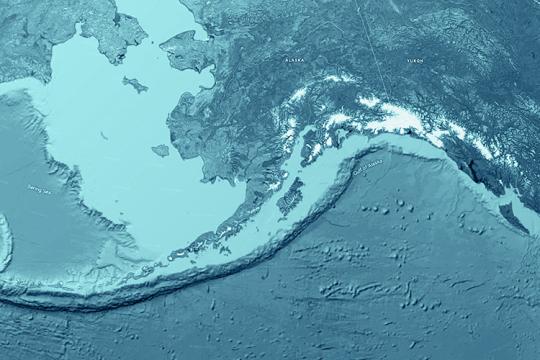 3D render and imaging of topographic map of Alaska showing the Gulf of Alaska, Aleutian Islands and Bering Sea. Satellite images courtesy of NASA. Credit: Frank Ramspott
3D render and imaging of topographic map of Alaska showing the Gulf of Alaska, Aleutian Islands and Bering Sea. Satellite images courtesy of NASA. Credit: Frank Ramspott
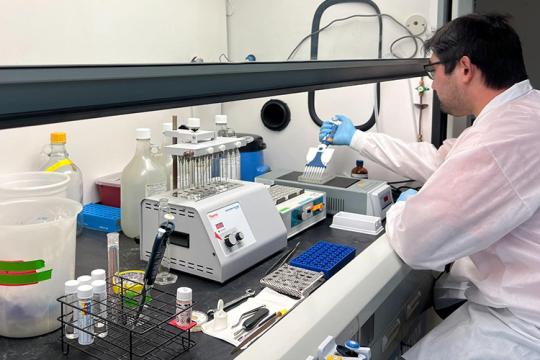 Bryan Cormack, fisheries biologist at the Alaska Fisheries Science Center, uses a multi-channel pipette for streamlined high-throughput processing using the sulfo-phospho-vanillin (SPV) assay. He processed more than 2,700 SPV samples this past year. Credit: NOAA Fisheries/Cody Pinger.
Bryan Cormack, fisheries biologist at the Alaska Fisheries Science Center, uses a multi-channel pipette for streamlined high-throughput processing using the sulfo-phospho-vanillin (SPV) assay. He processed more than 2,700 SPV samples this past year. Credit: NOAA Fisheries/Cody Pinger.
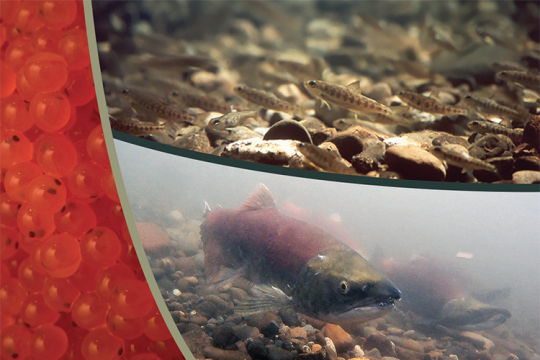
 A coho salmon swims up the Sol Duc river on the Olympic Peninsula. Credit: Adobe Stock.
A coho salmon swims up the Sol Duc river on the Olympic Peninsula. Credit: Adobe Stock.
Seafood Facts

Is Pink Salmon Sustainable?
U.S. wild-caught pink salmon is a smart seafood choice because it is sustainably managed and responsibly harvested under U.S. regulations.
Availability
Fresh from late summer to fall, and frozen and canned year-round.
Source
U.S. wild caught from Alaska, Washington, and Oregon.
Taste
Pink salmon has a low oil content so it’s generally lean and mild-flavored.
Texture
Softer meat than most salmon with a small flake.
Color
Pink salmon’s meat is pale pink and lacks the orange tint of other salmon species.
Health Benefits
Pink salmon is low in sodium and is a good source of omega-3 fatty acids, protein, niacin, vitamin B12, and selenium.
Nutrition Facts
Servings: 1; Serving Weight: 100 g (raw); Calories: 116; Protein: 19.94 g; Total Fat: 3.45 g; Total Saturated Fatty Acids: 0.558 g; Carbohydrate: 0 g; Total Sugars: 0 g; Total Dietary Fiber: 0 g; Cholesterol: 52 mg; Selenium: 44.6 mcg; Sodium: 67 mgMore Information
Pink Salmon Recipes
Pink salmon is a softer meat with small flakes that make a great pasta or soup. If you’re looking for cooking inspiration, browse these recipes for pink salmon bucatini, chowder, and more!

Last updated by NOAA Fisheries on 04/01/2025
Seafood News
 Celebrate Culinary Arts Month with a sustainable seafood recipe for every month of the year.
Celebrate Culinary Arts Month with a sustainable seafood recipe for every month of the year.
What Your Birth Month Says About Your Next Seafood Recipe
 Fresh-caught taʻape on ice. Credit: Conservation International Hawaiʻi.
Fresh-caught taʻape on ice. Credit: Conservation International Hawaiʻi.
Reducing Waste and Feeding Communities in Hawaiʻi with a Whole Fish Approach
 Chef Tyler Hadfield’s Curried Skate Wings with Tomato-Masala Chutney
Chef Tyler Hadfield’s Curried Skate Wings with Tomato-Masala Chutney
Ring In the New Year With These Crowd-Favorite Seafood Recipes
 NOAA Fisheries, in collaboration with Blue Ocean Mariculture, is conducting a multi-year pilot study to evaluate observational methods and tools for studying Hawaiian monk seal behavior. Courtesy of Blue Ocean Mariculture
NOAA Fisheries, in collaboration with Blue Ocean Mariculture, is conducting a multi-year pilot study to evaluate observational methods and tools for studying Hawaiian monk seal behavior. Courtesy of Blue Ocean Mariculture
AI Meets Aquaculture to Study Hawaiian Monk Seal Interactions With Net Pens
Last updated by NOAA Fisheries on 04/01/2025
Population Status
- Alaska:
- Pink salmon are the most abundant Pacific salmon.
- The Alaska Coho Salmon Assemblage consists of coho salmon, sockeye salmon, pink salmon, and chum salmon throughout southeast Alaska. There are 3 indicator stocks of coho salmon that are used to determine the status of the assemblage; these indicator stocks are Coho salmon - Auke Creek, Coho salmon - Berners River, and Coho salmon - Hugh Smith Lake. According to the 2022 Hugh Smith, Auke Creek, and Berners River stock assessments, these stocks are not overfished and not subject to overfishing. Summary stock assessment information can be found on Stock SMART.
- West Coast:
- The status of pink salmon on the West coast is unknown.
- Due to their unique two-year life cycle, returns of pink salmon are much larger in odd-numbered years.
- Populations are affected by:
- Changes in ocean and climatic conditions.
- Habitat loss from dam construction and urban development.
- Degraded water quality from agricultural and logging practices.
- Population conservation efforts include:
- Captive-rearing in hatcheries.
- Removal and modification of dams that obstruct salmon migration.
- Restoration of degraded habitat.
- Acquisition of key habitat.
- Improvements to water quality and instream flow.
- The Pacific Coastal Salmon Recovery Fund supports the restoration of salmon species.
Fishery Management
- NOAA Fisheries and the Pacific Fishery Management Council manage pink salmon on the West Coast.
- Managed under the Pacific Coast Salmon Plan:
- Every year, the council reviews reports of the previous fishing season and current estimates of salmon abundance. Using this information, they make recommendations for management of the upcoming fishing season.
- Their general goal is to allow fishermen to harvest the maximum amount of salmon that will support the fishery while preventing overharvest of the resource and ensuring that salmon populations with low abundance can rebuild.
- Specific management measures vary year to year depending on current salmon abundance, and include size limits, season length, quotas, and gear restrictions.
- The council usually increases harvest limits for pink salmon in odd years when more adults are returning to spawn.
- Management of pink salmon must also comply with laws such as the Endangered Species Act.
- Final recommendations are implemented by NOAA Fisheries. Check here for the current season’s management. State and tribal managers use council management recommendations to shape their policies for inland fisheries, to ensure that conservation objectives are met.
- NOAA Fisheries and the North Pacific Fishery Management Council manage pink salmon in Alaska.
- Managed under the Fishery Management Plan for Salmon Fisheries in the EEZ off the Coast of Alaska:
- All management of the salmon fisheries in federal waters is delegated to the State of Alaska, which is also responsible for managing the commercial, recreational, and subsistence fisheries for salmon in state waters. This ensures that management is consistent throughout salmon’s range.
- Managers regulate the fishery based on escapement goals to ensure harvests are sustainable. They want enough salmon to be able to escape the fishery and return to fresh water to spawn and replenish the population.
- Salmon fishery management largely relies on in-season assessment of how many salmon return to fresh water to spawn.
- Managers set harvest levels based on these returns. When abundance is high and the number of fish returning is much higher than that needed to meet escapement goals, harvest levels are set higher.
- In years of low abundance, harvest levels are lowered.
- During the fishing season, scientists monitor catch and escapement, comparing current returns with those from previous years, to keep an eye on abundance and actively manage the fishery.
- All management of the salmon fisheries in federal waters is delegated to the State of Alaska, which is also responsible for managing the commercial, recreational, and subsistence fisheries for salmon in state waters. This ensures that management is consistent throughout salmon’s range.
- Off the West Coast and in Alaska, the Pacific Salmon Treaty and the Pacific Salmon Commission help coordinate management, research, and enhancement of shared U.S. and international salmon stocks, including pink salmon.
Harvest
- Commercial fishery:
- In 2023, commercial harvest of pink salmon totaled approximately 425 million pounds and were valued at more than $101.4 million, according to the NOAA Fisheries commercial fishing landings database.
- Almost all the pink salmon harvested in the United States comes from Alaska fisheries.
- Small numbers of pink salmon are also harvested off the West Coast, mainly Washington, especially in odd-numbered years (see the Science section for more about pink salmon’s unique two-year life cycle).
- Gear types, habitat impacts, and bycatch:
- Purse seines, gillnets, and reef nets are used to catch pink salmon.
- Purse seiners catch salmon by encircling them with a long net and drawing the bottom closed to capture the fish.
- Gillnetters catch salmon by setting curtain-like nets perpendicular to the pink salmon trajectory as they migrate along the coast toward fresh water.
- Fishing gear used to catch pink salmon rarely contacts the ocean floor and has little impact on habitat.
- Bycatch is low and usually consists of other salmon species.
- Recreational fishery:
- Salmon are a favorite catch of recreational fishermen.
- Recreational fishermen use a variety of fishing gear to harvest pink salmon.
- While their relatively small size makes them less popular with sport anglers than other salmon species, pink salmon are excellent fish to catch because they’re aggressive and make a nice, mild-tasting meal.
- To ensure recreational fisheries are sustainable, West Coast anglers are only allowed to keep a certain number of salmon per fishing trip.
- In Alaska, regulations vary by area and individual fisheries.
- Recreational fisheries in high-use areas (Cook Inlet, Southeast Alaska, Copper River) are regulated through management plans that allocate fish between competing commercial and recreational fishermen.
- Subsistence fishery:
- Salmon is an important source of spiritual and physical sustenance for Western Indian tribes and Alaska natives, and salmon are culturally important to many other residents of these areas.
- Subsistence fishermen use a variety of fishing gear to harvest pink salmon.
Last updated by NOAA Fisheries on 04/01/2025
Science Overview

NOAA Fisheries conducts various research activities on the biology, behavior, and ecology of pink salmon. The results of this research are used to inform management decisions for this species.
For detailed information about stock status, management, assessments, and resource trends, you can search for pink salmon and any other species of interest using NOAA's StockSMART web tool.
Pink Salmon Research in Alaska
Our work to forecast salmon harvests, assess the impact of commercial fisheries on salmon, and evaluate how salmon populations respond to environmental changes enable us to estimate abundance and trends for pink salmon in Alaska.
More on salmon research in Alaska
Pink Salmon Research in the Pacific Northwest
Our research on Pacific salmon covers several topics including bycatch, salmon harvest forecasts, ecotoxicology, genetics, marine survival, and responses to climate change.
More Information
Recent Science Blogs
Last updated by NOAA Fisheries on 04/01/2025
Documents
Cook Inlet Small Entity Compliance Guide
The Small Entity Compliance Guide (select "View Document" below) contains a summary of regulations…
Final Review Draft for Proposed Amendment 51 to the FMP for BSAI King and Tanner Crabs, Amendment 17 to the FMP for the Scallop Fishery off Alaska, and Amendment 15 to the FMP for the Salmon Fisheries Compliance with Bycatch Reporting Methodology
Analysis of fishery management plan amendments regarding Standardized Bycatch Reporting…
Forecasting Pink Salmon Harvest In Southeast Alaska From Juvenile Salmon Abundance And Associated Biophysical Parameters: 2012 Returns And 2013 Forecast
The 2013 Salmon forecast - model selection included a review of Alaska ecosystem indicator…
Salmon, Cods and Skates Observer Training Guide
This documentation contains Salmon, Cods, and Skates identification information to assist North…
Data & Maps
Pacific Coastal Salmon Recovery Fund Database
The Pacific Coastal Salmon Recovery Fund (PCSRF) database serves as a project and performance…
Pink Salmon Data Collected Metadata
A database describing a 67-year time series for Sashin Creek pink salmon (Oncorhynchus gorbuscha)…
Annual Survey of Juvenile Salmon Ecologically-Related Species and Biophysical Factors in the Marine Waters of Southeastern Alaska
This annual survey, conducted by the Southeast Coastal Monitoring (SECM) project, marks 20…
Research
Genetics Research at the Alaska Fisheries Science Center
We conduct a variety of genetic research on Pacific salmon, groundfish, and forage fish species to comply with regional, national, and international agreements and treaties for managing marine resources.
Salmon Research In Alaska
Pacific salmon play an important role in Alaska’s marine ecosystems and are a valuable commercial, recreational, and subsistence resource. NOAA Fisheries scientists forecast salmon harvests, assess the impact of commercial fisheries on salmon, and evaluate how salmon populations respond to environmental changes. The information we provide helps managers make science-based decisions to ensure sustainable fish populations, fisheries, and fishing communities.
Southeast Alaska Coastal Monitoring Forecasting Reports
The Southeast Alaska Coastal Monitoring project has collected a time series of indexes that include juvenile salmon and their associated biophysical data in coastal Southeast Alaska since 1997. These reports document their forecasts of future Pink Salmon…
Southeast Alaska Coastal Monitoring Survey Reports
Southeast Alaska Coastal Monitoring project survey data on Juvenile Salmon in the Marine Waters of Southeastern Alaska.
Outreach & Education
Salmonid Savers – Word Puzzles, Mazes, and Games About Saving Salmon and Steelhead
Through comics, word puzzles, and mazes, kids learn about the importance of salmonids (e.g., salmon…
An Incredible Journey – Curriculum About Issues Affecting Salmon and How to Become a Salmon Steward
This curriculum includes 10 hands-on lesson plans that explore the salmon life cycle; the cultural,…
An Incredible Journey, a Children’s Book About Salmon
This book introduces young children to the salmon life cycle and concepts such as ecosystems,…
Last updated by NOAA Fisheries on 04/01/2025
